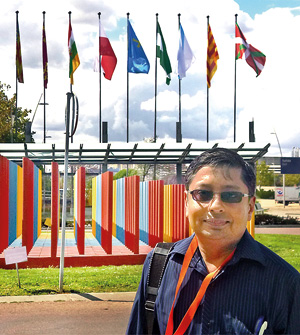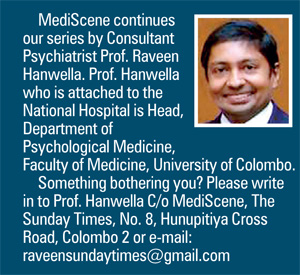Lessons from Madrid
View(s):The 16th World Congress of Psychiatry was held in Madrid, Spain from September 14 to 18 this year. Held every two years it is the largest gathering of mental health professionals from around the world. This time it was attended by nearly 10,000 delegates. A few psychiatrists from Sri Lanka including myself attended the conference. With parallel sessions in 20 rooms it was possible to attend only a few important sessions. I will share with you some important lessons we learnt from this conference.

Prof. Hanwella in Madrid
The first session we attended was titled “Current advances and innovations in electroconvulsive therapy”. The symposium was chaired by Prof Edward Shorter, psychiatrist and historian whose “History of Psychiatry” is the standard text in the field. Electroconvulsive therapy also known as shock therapy or ECT is one of the oldest treatments in psychiatry. It has been in use for over 75 years. It is a safe and effective treatment for severe depression and some other psychiatric conditions. During the procedure a controlled electric shock is passed through the brain. The patient is anaesthetised and feels no discomfort other than a possible mild headache afterwards. Even after all these years exactly how ECT works has remained a mystery.
Currently there are three main theories as to how ECT works. The first is that the current that passes through the brain, as well the seizure produced due to the shock, normalises the functioning of the brain. It is thought that production of a fit or seizure is essential for ECT to be effective. Electric currents that do not produce a fit have no effect on depression.
The second theory is a neuroendocrine theory. When people are stressed a hormone called cortisol is secreted into the blood stream. This helps the body produce extra sugar in the body providing an energy boost to cope with the stress. This is like increasing the engine revs in a motorcar to gain acceleration. If stress is persistent, or in states of depression, the cortisol level remains persistently high. This is harmful for the body. This is equivalent to maintaining persistently high revs in an engine leading to damage. An area of the brain called the hypothalamus controls the secretion of cortisol. ECT was thought to normalise the secretion of cortisol through its action on the hypothalamus.
The third theory is interesting. It was thought that ECT actually promotes the growth of nerve cells and nerve connections in the brain. This is called neurogenesis and synaptogenesis. Until recently there was no direct evidence for this theory. Recently there have been some remarkable studies done on rats and monkeys. It showed that rats when stressed, suffer loss of nerve cells and endings in the brain. When the rats are given electroshock, as in ECT, the cells regenerate. The same findings have been demonstrated on monkeys. Human studies are still awaited but still this is a remarkable finding. Rather than causing brain damage ECT regenerates nerve cells.
On another day of the conference we listened to an update on ADHD or Attention Deficit Hyperactivity Disorder. ADHD is a childhood condition characterised by inattention shown behaviourally as wandering off task, lacking persistence, difficulty in sustaining attention and being disorganised. Some children also have a hyperactivity component. Such children run about when not appropriate, fidget, tap, or talk excessively. There may also be impulsivity leading to dangerous behaviour such as darting onto a road without looking. In most cultures it is found in about 5% of children. In more than half the cases ADHD persists into adulthood and is then called adult ADHD. It should be noted that ADHD starts in childhood. It never starts in adulthood.
 The main treatment up to now has been stimulants. It might seem odd that we should use a stimulant to control hyperactivity. It is thought to work by stimulating those parts of the brain that control attention and activity levels in a person. This is like pressing the brakes to slow a motor vehicle. The stimulant that was originally used was amphetamine, and later methylphenidate, a variation with less additive potential. Atomoxetine is a non-stimulant drug that became available more recently for the treatment of ADHD. Though it may have fewer side effects than methylphenidate it is also less effective. Until now the mainstay of treatment has been methylphenidate in different formulations. Now a new drug, metadoxine has been found in trials to be effective in ADHD.
The main treatment up to now has been stimulants. It might seem odd that we should use a stimulant to control hyperactivity. It is thought to work by stimulating those parts of the brain that control attention and activity levels in a person. This is like pressing the brakes to slow a motor vehicle. The stimulant that was originally used was amphetamine, and later methylphenidate, a variation with less additive potential. Atomoxetine is a non-stimulant drug that became available more recently for the treatment of ADHD. Though it may have fewer side effects than methylphenidate it is also less effective. Until now the mainstay of treatment has been methylphenidate in different formulations. Now a new drug, metadoxine has been found in trials to be effective in ADHD.
Metadoxine is not a new drug. It has been used in some countries for several years for the treatment of alcohol problems. It is not yet available for general use but may have even less side effects than atomoxetine. An important point a speaker raised was the under treatment of ADHD. Concerns have been raised especially by non-medical health professionals that psychiatrists are over diagnosing and over treating children with ADHD. Even in the United States where the diagnosis of ADHD is made more often than in European countries it is undertreated. This is tragic as the effect of untreated ADHD on academic and social life is devastating and methylphenidate is a safe and effective treatment. As I said before the majority of children when they become adults continue to have symptoms of ADHD. In adults the hyperactivity component is less and the inattentiveness is the more prominent symptom. Therefore it is more difficult to diagnose in adults than in children. Adult ADHD can seriously effect functioning at work. The treatment is the same as for childhood ADHD.
One day we took time off from the conference to visit the Prado museum in central Madrid, one of the finest repositories of European art. The Prado is a huge museum and our group of not too artistically minded psychiatrists did not expect to spend too much time in it. But seeing the magnificent paintings by Goya, El Greco, Titian and Rubens, some painted more than 500 years ago, but still looking as fresh as the day on which they were painted, we were mesmerised. We left the museum six hours later! Perhaps some of our brain cells had regenerated in the contemplation of beauty.


